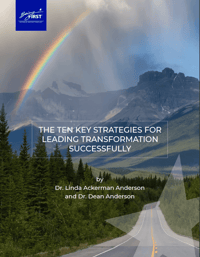All project sponsors want to secure the best content solution for the issue they are solving, especially if it is at the level of an organizational breakthrough. In fact, this is the easy part of leading change. History shows us that the cause of failure is rarely that the solution was wrong; it is more often that the organization could not adapt, adopt, or integrate with it.
When determining your scope of change, think beyond defining the problem you are trying to solve and consider the implications of the change that you imagine would best serve the organization. This requires expanding your view of the solution’s requirements and its impacts on the organization and your people. What would a radically different future require?
Elements of a Full Scope of Change
Your change initiative may target business strategy, structure, business processes, IT, policies, or any other myriad aspects of the organization. Most project leaders determine scope at the very beginning of a change, and only focus on the solution to these elements. But if you think ahead to the implications of implementing such a solution, you will see it impacts people’s jobs, culture, relationships, competencies, and knowledge needed for it to flourish over time. All this needs attention and strategy so you minimize the negative impacts of the change and make the process as smooth as possible. No solution will sustain if everything is not considered, planned for, aligned, and supported from start to finish. This takes time, resources, and expertise. And it all belongs in scope.
Give serious attention to every aspect of the organization that requires a breakthrough, and name it as clearly as you can.Implications of Expanding Your Scope of Change
Everything that is touched or changed in the organization and its people needs change leadership attention. Your role as change sponsor is not to do this work; you assumedly have a talented and intelligent team to do this. However, your job is to ensure that your initiative is scoped accurately and fully. The scope of a project drives the financial resources you require to do this work, the time it will take to accomplish it all, and the types of expertise you enroll on your project team from the beginning.
If you are going for a breakthrough results, make sure your finger prints are all over a full scope.What to Consider in Scope
There are many facets of scope to consider. To assist your full assessment, picture your potential solution in action: What is happening? Which departments, teams, or individuals are involved in making it work? What other parts of the organization are impacted or required to do their part? How are people responding? How are they treating each other? How are they supporting what is best for the organization’s overall breakthrough? To assist the early scoping process, we use a simple tool called “Initial Impact Analysis” to help you thinking through potential areas of scope and impact. Consider having your project leaders, team, or even a few supportive stakeholders fill it out. You might be surprised by the number of aspects that must be accounted for. This tool is not meant to increase the workload of your change. It is designed to expand your understanding of the actual work that will be required for you to get your outcome.
Of everything you check, identify if the impact is minimal or at the level of breakthrough. This will help determine the work required to achieve your outcome.Benefits of Defining a Full Scope from the Start
Good executive sponsorship is about ensuring that you have the best strategy and conditions for a successful change initiative, ideally at launch. Only when you understand your full scope from the start can your team design a change process to minimize the negative effects on your people, discover and respond to misalignments with other parts of the organization, minimize re-dos, and ensure better adoption and sustainment of breakthrough outcomes. Be strategic!
Get involved in understanding the early implications of the solution you imagine, and then ensure that your effort is set up to have that work occur in the most expedient way.
Related Webinar:
Sponsor-Project Lead Partnership Best Practices Proven to Maximize Transformation Results
Instructor: Dr. Linda Ackerman Anderson
This webinar explores a four-step process for creating an effective sponsor-project lead partnership and the proven principles that drive it. You’ll get our best practices and tips for building a sponsor-project lead partnership derived from our 40+ years as experts in leading transformation.
Featured eBook:
The Ten Key Strategies for Leading Transformation

Through 40 years of observing and supporting large-scale change and transformation in Fortune 500, government, global NGOs and public service organizations, we’ve identified these ten Best Practice strategies for leading transformation successfully.
Please complete the form to download your eBook:

